Fujimi 1/72 B7A1 “Grace” – Training colors
Having just viewed Milan's beautifully done Grace, and having not posted in some time (still racking up hours decalling my MiG-31...), I decided to yank this out of my display case and post it, just to have a couple versions of the Grace to view.
I built this before I started including pilots in every build, so even though it's wheels up, it looks like a drone! I also didn't really do any weathering, chipping, oil staining or such, other than my first attempt at a wash with oils (more on that below).
I have an old Hasegawa Rita in my stash, and the box art shows it in this orange training color. Before attempting that on a canvas that large, I wanted to try it on a smaller aircraft, and had this Fujimi kit in my stash, with box art also showing the trainer orange scheme.
It took me awhile to find an orange I wanted to use - ended up being Humbrol. This is my first (and probably last) attempt with Humbrol paint, as I brush paint and didn't like the consistency, nor having to fiddle with those obnoxious (or is the correct term "bloody") tins!
Once the orange was on, I wanted to tone it down a bit. I'd read about using oil dot filtering and oil washes, so thought I'd get some brown oil paint and mineral spirits and have a go.
For a first attempt, I'm not overly embarrassed! I did learn a bit working with oils - how quickly they start to get "hard to work" even loading the brush with fresh mineral spirits. The effect came off much heavier than I'd intended, but at least it doesn't look like it just rolled off the factory floor. I also noticed that using mineral spirits leaves a different sheen on the surface. It's really a subtle semi-gloss look, and if gloss is the intended finish for 1/72 scale, I think it works. However, if you really want to stay flat, you need to apply a dullcoat to take the sheen back down.
Even though this is only about 4 years old, I consider it one of my "older" builds, and I'm now spending more time on the finish to get a more realistic appearance.
The result of the project: I'm still undecided on finishing my Rita in orange! It seems the Japanese didn't have a lot of variety in their aircraft finishes, but I don't really want several shelves with aircraft looking all the same (see my J2M3 for another attempt to get away from that), so perhaps I'll get bold and try it again. If on the Rita though, I will spray (rattle cans) if I can find the right shade.
Please feel free to suggest any hints/tips etc. that could make me a better modeler! You won't hurt my feelings! (by the way - I've decided to include this postscript in all my posts. I've noticed that occasionally, someone will make a comment that on the surface can seem critical, but it really is an attempt to pass on experience and advice. I LOVE learning from others, and enjoy reading those particular comments!)
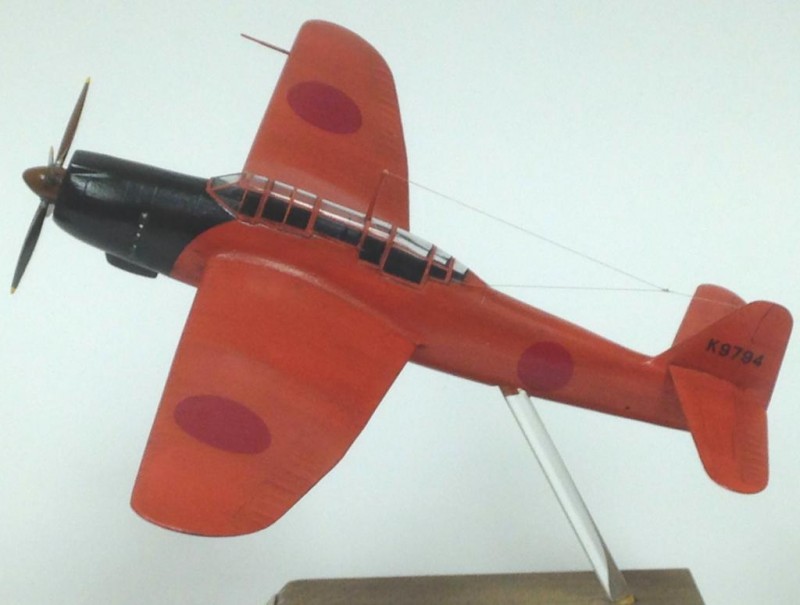
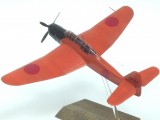

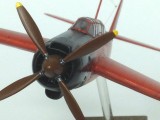
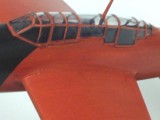
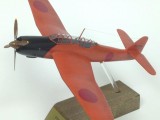
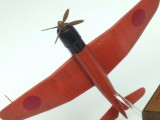
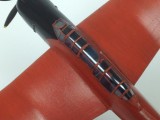
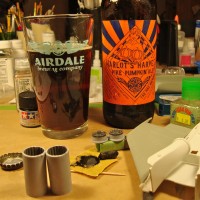
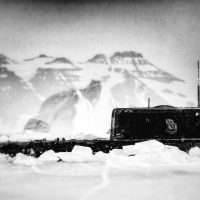
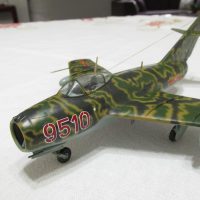
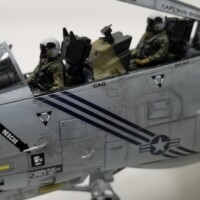
Hi Greg, this is a double Grace day, fantastic. I like it a lot, it surely look very impressive to see your collection in office.
From my experience, white, yellow and orange are the hardest colors to brush paint. Therefore, I would suggest you to find a suitable spray-can for Rita. If you are planning to get an airbrush - even better. In any case, start with very light colored primer preferably white (gunze mr. white primer or such). I think tamiya has some rattle can orange for those Jagermeister colored racing cars.
Greg, somewhere I read that IJN orange is available in Testors' automotive line, in a spray. lacquer, 1970, Grabber Orange. There's also a Hugger Orange, so I could be confused, which is my normal state, anyhow.
For the IJAAF, Humbrol has a vivid orange called orange lining(?), which I think was a railway colour. (ha!) Harvey Low suggested that in an article in FineScale sometime back.
I've got a Hasegawa Zero Trainer I was planning to use the orange on.
Gunze has a color reputedly used on IJN trainers, which is yellower.
Others may know more, hope this is some help, let me know what you think.
I've got a Rita, too. I like the orange scheme, as well. Beats green and gray.
As to the Humbrol, for a while their paint was being made in China, and there were issues.
I also hear that sometimes if you open the tin, and let it sit awhile, it's easier to then use. Whether that applies to the offshore stuff, or the more recent, I can't say.
They're back in Britain, and things may have improved.
I've got a bunch of their older stuff, and it is as good as when it came out of Marfleet, Humber.
Oh, and Floquil had an orange called boxcar orange, which also supposedly was a good match. They are now out of business, but some of their residue may be found on shelves in various hobby and train shops.
Thanks for all the suggestions! I think I'm leaning back to the orange scheme for the Rita!
Nicely done, Greg...I like it.
Greg, I normally don't care for the training colors, but with the black cowl, this actually looks pretty cool. I also don't recall ever seeing a grace airborne, so seeing what you've done here is a double bonus. Nice work.
Terry, IJN also used the color for prototype aircraft, as well, almost to the end of the war. Like the Rita mentioned, which was a four engined bomber prototype. One was brought to the US after the war. There is a picture of it sitting on the ramp someplace stateside, in that orange scheme. The engine cowlings are in natural metal.
Put US insignia on it, and the rivet counters will go nuts. Anoraks to you UK folks.
Your orange Grace has attracted some interesting comments about paints, Greg, so, two jobs in one, good work! I like both colour schemes, but yours does make for a change.
Another nice addition to the recent Japanese theme.
The points re Humbrol are interesting. As far as I know we've never been without it in Europe, wherever it was produced. I always spray with it rather than brush it, at least in larger areas, as I prefer enamels, and it's fine. White Ensign Modeks paints are probably the finest I've used. They can sit on the shelf for ages and still be good to go with a light stir, and the range is targeted to finishes by-country: Japan, Germany, etc. The trouble with WEM at the moment is that they shut down last year and a company said to be taking over the range hasn't made the paints available again (at least that's my understanding). we now have the Model Master range available more widely here, and I rate them highly.
A suggestion on weathering trainer colours - rather than pre-shade and all that, just spray your main colour overall, and follow up with the same colour tinted lighter, used at the centre of panels, which provides two important elements, (1) a nice faded look in the centres and (2) by leaving the panel edges/lines in original colour these areas appear darker compared to the centres and so look a little more naturally dirty without the overblown 'chimney soot' appearance that pre-shading affects.
Rob, thanks for the tip about the panels.
Shame about WEM. We'll hope for the best. I always got a kick out of John Snyders comments.
Me, I miss Pactra and Floquil.
I agree !
I appreciate the suggestions for weathering trainer colors (or any single color scheme for that matter), but I don't own/use an airbrush, so I have to use other techniques for now! Maybe some day...
Yes I meant to say the method works equally well with any camo finish. It can also be used with bare metal schemes by altering the metal brightness, e.g., a dull aluminium with white aluminium centres, and so forth (Alcald or similar).
She looks mighty fine. I only use Humbrol and Model Master. I stay clear of Acrylic paint. Too many bad experiences on that road. Well done Greg!
I had good success brush painting with Polly S years ago, but have never liked MM acrylics - could never mask them among other issues. I've had success recently with Vallejo acrylics (model color, not model air). Their self-leveling properties leave less brush stroke issues. They are more delicate - have to be careful with masking, etc., and occasionally have to touch up after all the weathering and such.
I like it a lot Greg, I'm especially impressed with the sharpness of your canopy framing, not easy to make convincing in 1/72. I don't personally find your weathering at all overdone either. If I had one comment, it's the glossiness of the finish (which you've already mentioned). A light coat of rattle-can matt varnish would do the trick, although it would be a pain masking that canopy again!
Thanks Mike! When I brush paint, I typically don't mask each canopy pane like those of you who spray do, but mask the frames running in each direction separately, paint, then mask the others, paint, etc. May seem like more work, but it's much easier than having to cut custom masks for each canopy - especially in 1/72!
Since I generally paint with flat and finish to flat, I don't add the canopy until after I've dullcoated the entire aircraft - canopy is usually the finishing touch, with perhaps a little touch up paint to blend into the fuselage.
For this finish, I wasn't sure if IJN trainers were gloss or flat finish, so went with semi-gloss. (Does anyone know the answer?) To do that, I generally use Future / Pledge on the canopy and frames to bring back the gloss if the frames were finished in flat paint.
PS if you haven't come across them before, I'd recommend http://arawasi-wildeagles.blogspot.jp for great history and details of Japanese aviation. They offer colour profiles, archive images and other points of interest.
Very nice work and paint finish!
Looks great !
Nice one Greg, I like it
A fine one, Greg and you can t oversee it in your collection :). The japanese did a lot of great looking aircraft, this is one of them and you did a sharp looking build out of it